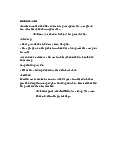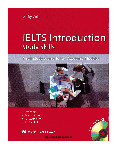



Preview text:
KTQT_ LÝ THUYẾT CHAPTER 1:
Financial accounting: Field of accounting that reports financial position
and income according to accounting rules.
Cost accounting: Field of accounting that measures records, and reports information about cost
Manage cost: Cost management is the analysis of necessary information
for the management of an enterprise. This information includes both
financial information (costs and revenues) as well as non-financial
information (productivity, quality and other factors of the business. CHAPTER 2:
Fixed cost: Cost that are unchanged as volume changes within the relevant range of activity.
Variable cost: Costs that change in direct proportion with a change in
volume within the relevant range of activity. CHAPTER 3:
CVP analysis: Study of the relations among revenue, cost and volume and their effect on profit.
Profit equation: Operating profit equals total revenue less total costs.
OP = Total Revenues - Total Cost Profit = TR - TC
Total revenue = Price x Units of output produced and sold
=> Profit = (Price - Variable cost) x Units of output - Fixed costs
Unit contribution margin: Difference between revenues per unit (price) and variable cost per unit.
Total contribution margin: Difference between revenues and total variable costs.
BEP: Volume level at which profits equal zero.
Break-even Volume in Units: We can use the profit equation to find the BEP expressed in units:
Break-even volume in units = Fixed cost / Unit contribution margin
Break-even Volume in Dollars: To find the break-even volume in terms of
sales dollars, we first define a new term, contribution margin ratio.
Break-even volume in dollars = Fixed cost / Contribution margin ratio
Contribution margin ratio: Contribution margin as a percentage of sales revenue.
Contribution margin ratio = Unit contribution margin/Sales price per unit Target volume in Units:
Target volume in Units = FC + target profit / Unit contribution margin Target volume in Dollars:
Target volume in Dollars = FC + target profit / Contribution margin ratio
Cost structure: Proportion of an organization’s fixed and variable costs to its total cost.
Operating leverage: Extent to which an organization’s cost structure is made up of fixed costs.
Margin of safety: The excess of projected or actual sales over the break- even volume.
Margin of safety = Sales volume - Break-even sales volume
Margin of safety percentage: The excess of projected or actual sales over
the break-even volume expressed as a percentage of actual sales volume. INCOME TAXES:
After - tax profit = [(P-V)X-F] x (1 - t)
Target volume in units = FC + [Target profit / (1-t)] / Unit contribution margin CHAPTER 4:
Differential analysis: Process of estimating revenues and costs of
alternative actions available to decisions makers and of comparing these estimates to the status quo.
Difference costs: With two or more alternatives costs that differ among or between alternatives.
Sunk costs: Costs incurred in the past that cannot be changed by present or future decisions.
Full cost: Sum of all fixed and variable costs of manufacturing and selling a unit.
Special order: Order that will not affect other sales and is usually a short run occurrence.
Target price: Price based on customers perceived value for the product
and the price that competitors charge.
Target cost: Equals the target price minus the desired profit margin.
Predatory pricing: Practice of selling price bellow cost with the intent to
drive competitors out of business.
Dumping: Exporting a product to another country at a price below domestic price.
Make-or-buy decision: Decision concerning whether to make needed
goods internally or purchase them from outside sources.
Price fixing: Agreement among business competitors to set prices at a particular level.
Price discrimination: Practice of selling identical goods to different customers at different prices.
Peak-load pricing: Practice of selling prices highest when the quantity
demanded for the product approaches capacity.
Contribution margin per unit of scarce resource: Contribution margin per
unit of a particular input with limited availability. F END F




